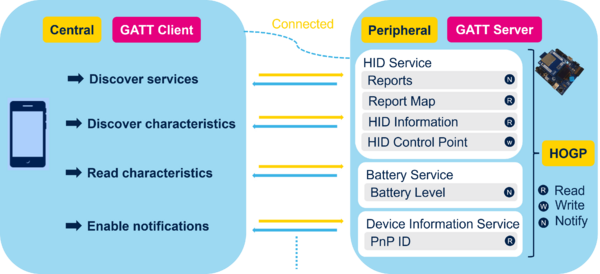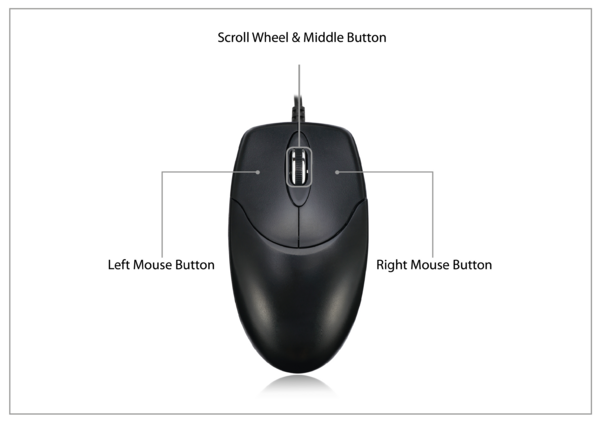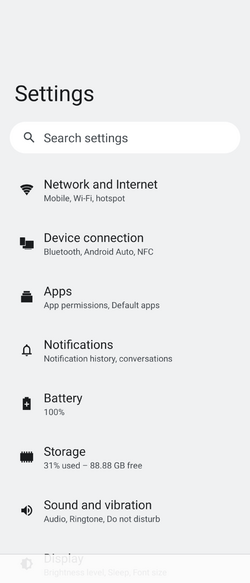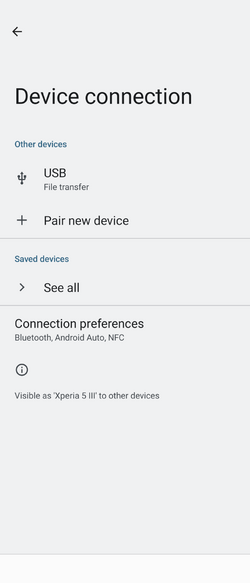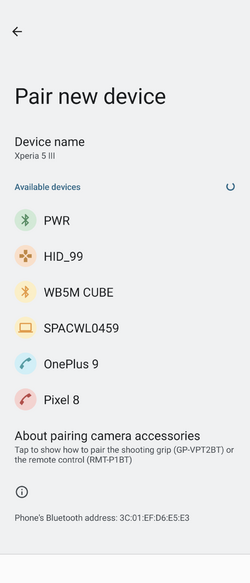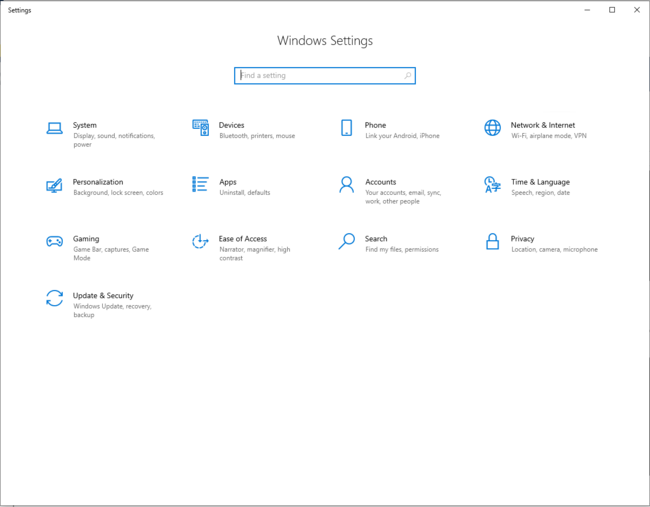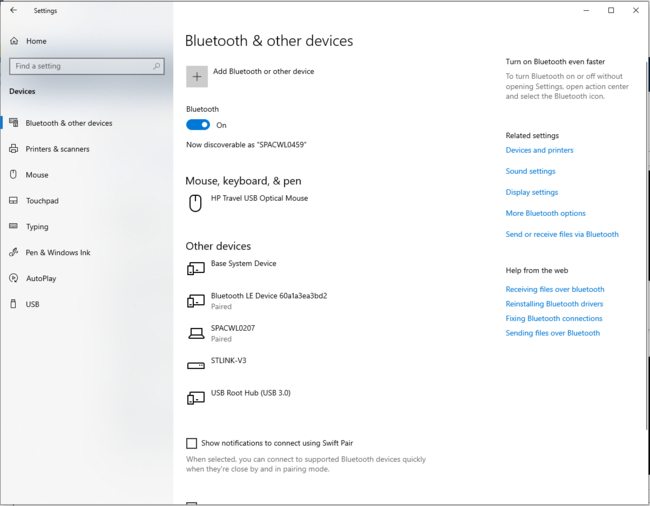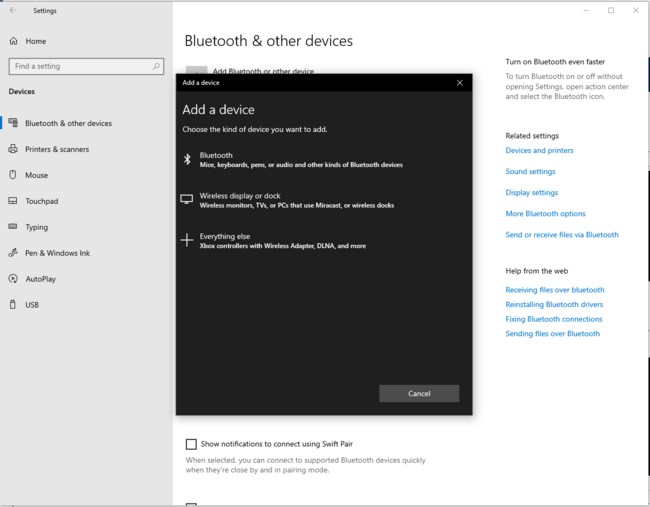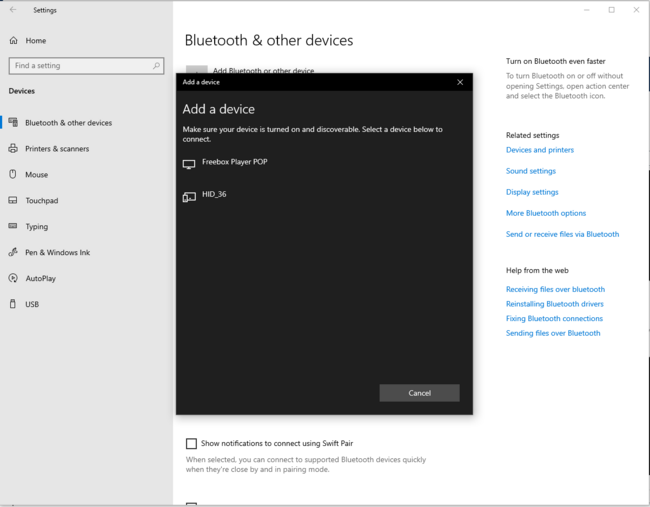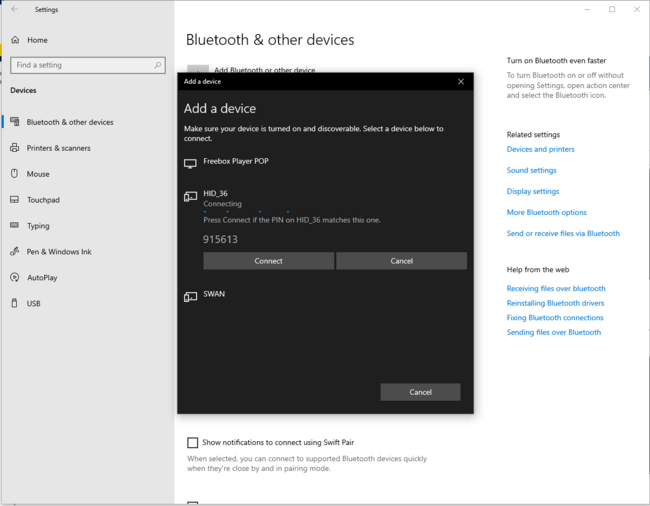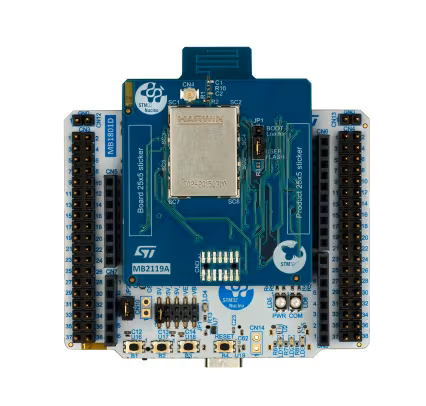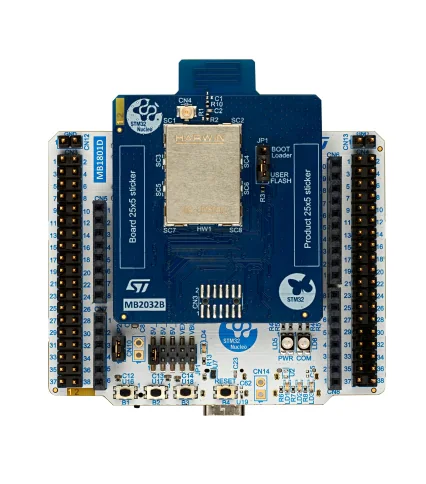1. Human interface device over generic attribute profile
Human interface device over GATT profile (HOGP)[1] is a low-energy profile, based on the generic attribute profile (GATT) defined by the Bluetooth® special interest group (SIG)[2]
This profile is an adaptation of the USB human interface device (HID) specification[3] to operate over a Bluetooth® LE wireless link. This profile operates on Bluetooth® LE transport only.
The profile defines three roles:
- The human interface device (HID) is a GATT server.
- The boot host is a GATT client.
- The report host is a GATT client.
Bluetooth® LE devices are not supported by PC BIOS, because the Bluetooth® LE stack and drivers are not loaded at this point yet, so the boot host role cannot be used with clients like PCs, smartphones, or tablets.
| Bluetooth® LE HOGP: report host and HID device |
|---|
The report host supports the scan client role of the scan parameters profile.
The HID device has:
- One or more instances of the HID service.
- One or more instances of the battery service.
- A single instance of the device information service.
- Optionally, one instance of the scan parameters service as part of the scan server role of the scan parameters profile.
- Optionally, a single or multiple instances of other services.
This wiki page describes the HID mouse and HID keyboard projects, provided with the STM32CubeWB0 MCU Package[4]
| Bluetooth® LE HOGP mouse and keyboard profile with STM32WB0 |
|---|
The table below describes the structure of HOGP services:
| Bluetooth® LE HOGP profile specification | |||||||||||||||||||||||||||||||||||||||||||||||||||||||||||||||||||||||||||||||||||||
|---|---|---|---|---|---|---|---|---|---|---|---|---|---|---|---|---|---|---|---|---|---|---|---|---|---|---|---|---|---|---|---|---|---|---|---|---|---|---|---|---|---|---|---|---|---|---|---|---|---|---|---|---|---|---|---|---|---|---|---|---|---|---|---|---|---|---|---|---|---|---|---|---|---|---|---|---|---|---|---|---|---|---|---|---|---|
|
The table below describes the HID report characteristic descriptors:
| Bluetooth® LE HID report characteristic descriptors specification | ||||||||||||||||
|---|---|---|---|---|---|---|---|---|---|---|---|---|---|---|---|---|
|
The table below describes the battery level characteristic descriptor:
| Bluetooth® LE battery level characteristic descriptor specification | ||||||||||||
|---|---|---|---|---|---|---|---|---|---|---|---|---|
|
The table below describes the Scan Refresh characteristic descriptors:
| Bluetooth® LE scan refresh characteristic descriptor specification | ||||||||||||
|---|---|---|---|---|---|---|---|---|---|---|---|---|
|
HOGP is a combination of a HID device and a report host to connect and exchange data in different applications.
The generic access profile (GAP) defines and manages advertising and connection.
| Report host central device and HID peripheral device |
|---|
The generic attribute profile (GATT) defines and manages in/out data exchanges.
| Report host GATT client device and HID GATT service device |
|---|
| Examples of an HID flow diagram between a STM32WB0 Serire board and a Bluetooth® LE PC or Bluetooth® LE smartphone |
|---|
1.1. STMicroelectronics manufacturer advertising data
At startup, HID device application (mouse/keyboard) starts fast advertising (80ms/100ms), including the STMicroelectronics manufacturer advertising elements[5] described below:
| HID device STMicroelectronics manufacturer advertising data | |||||||||||||||||||||||||||||||||
|---|---|---|---|---|---|---|---|---|---|---|---|---|---|---|---|---|---|---|---|---|---|---|---|---|---|---|---|---|---|---|---|---|---|
|
Advertising is switched to low-power advertising (1s/2.5s) after 60 seconds.
2. Requirements
2.1. Software and Hardware requirements
For software and hardware requirements refer to STM32WB0 Build BLE Project wiki page.
2.2. Collector applications compatible
The STM32CubeWB0 HID mouse project is compatible with the following collectors:
The STM32CubeWB0 HID keyboard project is compatible with the following collectors:
3. HID Mouse device example description
3.1. Project directory
The "BLE_HID_Mouse" application is available by downloading the STM32CubeWB0 MCU Package[6], in the following folder:
- STM32Cube_FW_WB0_Vx.y.z\Projects\NUCLEO-WB05KZ\Applications\BLE\BLE_HID_Mouse
- STM32Cube_FW_WB0_Vx.y.z\Projects\NUCLEO-WB07CC\Applications\BLE\BLE_HID_Mouse
- STM32Cube_FW_WB0_Vx.y.z\Projects\NUCLEO-WB09KE\Applications\BLE\BLE_HID_Mouse
Refer to How to Build a Bluetooth® Low Energy project Wiki page for project directory information.
3.2. Project description
3.2.1. Structure
The figure below shows a software project structure, highlighting the most important parts:
| HID mouse project structure |
|---|
3.2.2. Application initialization
The figure below details the different steps of the application initialization.
| HID mouse project initialization |
|---|
3.2.3. GAP and GATT initialization and interaction
The Bluetooth® LE HID mouse application initialization is done within app_ble.c.
- Initialize the Bluetooth® LE stack, initialize the device as a peripheral, and configure and start advertising: ADV parameters, local name, and UUID - APP_BLE_init().
- Call the services controller initialization BLEEVT_Init() - ble_evt.c.
- Manage the GAP event - BLEEVT_App_Notification()
- HCI_LE_CONNECTION_COMPLETE_SUBEVT_CODE- provides information of the connection interval, slave latency, supervision timeout
- HCI_LE_CONNECTION_UPDATE_COMPLETE_SUBEVT_CODE- provides the new information of the connection
- HCI_DISCONNECTION_COMPLETE_EVT_CODE- informs the application about the link disconnection and the reason
Event management is done by the Bluetoooth® LE Event Dispatcher, ble_evt.c.
- Initialize the number of registered handler - BLEEVT_Init()
- Manage events - BLE_STACK_Event() - from the Bluetooth® LE Host Stack and redirect them to the event handler - BLEEVT_App_Notification
The application level of the HID mouse device is done with hids_app.c.
- Initialization of the services:
- HID Service: HIDS_Init() in hids.c
- Initialization of the context of the application:
- Report map
- HID information
- Receive notifications from the HID service - HIDS_Notification().
- When the remote enables the input report characteristic, it's possible to see the mouse pointer move in the display of paired computer or phone. This is a simulation of mouse movement: every 1 second the pointer moves on a fixed coordinate.
The HID service hids.c manages the specification of the service:
- Service init (HIDS_Init()):
- Registers the HID event handle to the service controller: BLEEVT_RegisterGattEvtHandler(HIDS_EventHandler).
- Initializes the service UUID and adds the HID service as a primary service.
- Initializes the report map characteristic.
- Initializes the HID information characteristic.
- Manages the GATT event from the Bluetooth® LE stack (HIDS_EventHandler()).
- ACI_GATT_SRV_WRITE_VSEVT_CODE:
- Reception of a write command: HID control point characteristic value.
- Sending of an aci_gatt_srv_resp() with an OK or KO status.
- Notification to the application to suspend or exit suspend (HIDS_Notification(HIDS_HCP_WRITE_NO_RESP_EVT)).
- Reception of a write command: HID control point characteristic value.
- ACI_GATT_SRV_ATTRIBUTE_MODIFIED_VSEVT_CODE:
- Reception of an attribute modification - input report characteristics description value: enable or disable notification.
- Notify application of the input report notification (HIDS_Notification(HIDS_INPUTREP_NOTIFY_ENABLED_EVT/HIDS_INPUTREP_NOTIFY_DISABLED_EVT)).
- Reception of an attribute modification - input report characteristics description value: enable or disable notification.
- ACI_GATT_SRV_WRITE_VSEVT_CODE:
3.2.4. Report map and input report
HID report map characteristics should contain the USB HID descriptor, specified in the USB HID specification[3].
A USB HID descriptor is a hard-coded array of bytes describing the data packets of the device, including:
- The number of packets supported
- The packet size
- The purpose of each byte and bit in the packet
The figures below show an example of a USB mouse HID descriptor for a three-button mouse with X and Y axes and a wheel.
| USB mouse HID descriptor |
|---|
uint8_t reportDesc[] = {
0x05, 0x01, //USAGE_PAGE(Generic Desktop)
0x09, 0x02, //USAGE(Mouse)
0xA1, 0x01, //COLLECTION(Application)
0x85, REPORT_ID, // REPORT ID
0x09, 0x01, //USAGE(Pointer)
0xA1, 0x00, //COLLECTION(Physical)
0x05, 0x09, //USAGE_PAGE(Button)
0x19, 0x01, //USAGE_MINIMUM(Button 1)
0x29, 0x03, //USAGE_MAXIMUM(Button 3)
0x15, 0x00, //LOGICAL_MINIMUM(0)
0x25, 0x01, //LOGICAL_MAXIMUM(1)
0x75, 0x01, //REPORT_SIZE(1)
0x95, 0x03, //REPORT_COUNT(3)
0x81, 0x02, //INPUT(Data, Variable, Absolute) ; Button states
0x75, 0x05, //REPORT_SIZE(5)
0x95, 0x01, //REPORT_COUNT(1)
0x81, 0x01, //INPUT(Constant, Variable, Absolute) ; Reserved bits
0x05, 0x01, //USAGE_PAGE(Generic Desktop)
0x09, 0x30, //USAGE(X)
0x09, 0x31, //USAGE(Y)
0x16, 0x01, 0xF8, //LOGICAL_MINIMUM(-2047)
0x26, 0xFF, 0x07, //LOGICAL_MAXIMUM(2047)
0x75, 0x0C, //REPORT_SIZE(12 bits)
0x95, 0x02, //REPORT_COUNT(2)
0x81, 0x06, //INPUT(Data, Variable, Relative) ; X & Y
0x09, 0x38, //USAGE(Z)
0x15, 0x81, //LOGICAL_MINIMUM(-127)
0x25, 0x7F, //LOGICAL_MAXIMUM(127)
0x75, 0x08, //REPORT_SIZE(8)
0x95, 0x01, //REPORT_COUNT(1)
0x81, 0x06, //INPUT(Data, Variable, Relative) ; Z
0xC0, //END_COLLECTION
0xC0 //END_COLLECTION
};
|
| Three-button mouse with X and Y axes and a wheel |
|---|
All hard-coded bytes are described in the USB HID usage tables document[7].This USB HID descriptor also defines the data structure sent in the associated reports (input, output, or feature).
In this USB mouse HID descriptor example, you can find:
- Highlighted in green, the definition of three buttons represented by the first three bits of a byte that can have the boolean state 0 or 1. Bits 0, 1, and 2 represent the states of respectively the left, middle, and right buttons of the mouse. The remaining bits of the byte are unused.
- Highlighted in blue, the definition of three bytes for the X and Y axes for relative movement and wheel rotation. Each byte represents a signed integer that can take a value comprised between -127 to 127.
The figure below shows an example of the input report associated with the USB mouse HID descriptor.
| Data structure for a three-button mouse with X and Y axes and a wheel |
|---|
3.3. How to use the Bluetooth® LE HID mouse application
Once the Bluetooth® LE HID mouse application is installed on the STM32WB0 nucleo board, launch a Bluetooth® LE connection on a smartphone or a PC. Then, scan and connect the device called HID_XX (where XX is replaced by the last byte of the BD address) to the application.
3.3.1. Android Bluetooth® LE HID mouse
| Android Bluetooth® LE HID mouse connection – How to | ||||
|---|---|---|---|---|
3.3.2. PC Bluetooth® LE HID mouse
| PC Bluetooth® LE HID mouse – How to | |
|---|---|
| PC Bluetooth® LE HID mouse – How to | |
|---|---|
| PC Bluetooth® LE HID mouse – How to | |
|---|---|
| PC Bluetooth® LE HID mouse – How to | |
|---|---|
3.3.3. Bluetooth® LE HID mouse how to
Once the Bluetooth® LE connection is established and the notification enabled by the smartphone or the PC, the HID input report is sent every 1 second and the smartphone or the PC pointer moves on a fixed coordinate (This is a simulation of mouse movement).
NUCLEO-WB05KZ/NUCLEO-WB07CC/NUCLEO-WB09KE are necessary to install the application.
| Hardware platform illustration | ||
|---|---|---|
| NUCLEO-WB05KZ | NUCLEO-WB07CC | NUCLEO-WB09KE |
|
|
||
3.4. Low-power optimization
The project is delivered with the full system low-power feature disabled:
- Debug trace enabled
- Debugger enabled, even in Low-power mode
It is possible to enable/disable the low-power feature within app_conf.h:
/******************************************************************************
* Low Power
*
* When CFG_FULL_LOW_POWER is set to 1, the system is configured in full
* low power mode. It means that all what can have an impact on the consumptions
* are powered down.(For instance LED, Access to Debugger, Etc.)
*
* When CFG_LPM_SUPPORTED and CFG_FULL_LOW_EMULATED are both set to 1, the system is configured to
* emulate the Deepstop mode without losing the debugger connection and breakpoints nor watchpoints.
*
******************************************************************************/
#define CFG_FULL_LOW_POWER (0)
#define CFG_LPM_SUPPORTED (0)
#define CFG_LPM_EMULATED (0)
3.5. UART debug trace
With the debug log via UART interface it is possible to trace the application project.
To enable the traces within the project, enable them in app_conf.h as described below:
/*****************************************************************************
* Traces
* Enable or Disable traces in application
* When CFG_DEBUG_TRACE is set, traces are activated
*
* Note : Refer to utilities_conf.h file in order to details
* the level of traces : CFG_DEBUG_TRACE_FULL or CFG_DEBUG_TRACE_LIGHT
*****************************************************************************/
/**
* Enable or disable debug prints.
*/
#define CFG_DEBUG_APP_TRACE (1)
/**
* Use or not advanced trace module. UART interrupts to be enabled.
*/
#define CFG_DEBUG_APP_ADV_TRACE (0)
#define ADV_TRACE_TIMESTAMP_ENABLE (0)
| HID mouse - initialization phase | HID mouse - connected phase |
|---|---|
==>> Start BLE_Init function
Success: aci_hal_set_tx_power_level command
Success: aci_gatt_srv_profile_init command
Success: aci_gap_init command
Static Random Bluetooth Address: e3:39:09:d2:dc:fb
Success: Gap_profile_set_dev_name - Device Name
Success: Gap_profile_set_appearance - Appearance
Success: aci_gap_set_io_capability command
Success: aci_gap_set_security_requirements command
Success: aci_gap_configure_filter_accept_and_resolving_list command
==>> End BLE_Init function
Services and Characteristics creation
Success: aci_gatt_srv_add_service command: HIDS
Success: aci_gatt_srv_add_service command: DIS
Success: aci_gatt_srv_add_service command: BAS
Success: aci_gatt_srv_add_service command: SCPS
End of Services and Characteristics creation
==>> Success: aci_gap_set_advertising_configuration
==>> Success: aci_gap_set_advertising_data
==>> Success: aci_gap_set_advertising_enable
|
>>== hci_le_connection_complete_event - Connection handle: 0x0801
- Connection established with @:7a:1b:79:e0:18:34
- Connection Interval: 48.75 ms
- Connection latency: 0
- Supervision Timeout: 5000 ms
>>== HCI_LE_CONNECTION_UPDATE_COMPLETE_SUBEVT_CODE
- Connection Interval: 7.50 ms
- Connection latency: 0
- Supervision Timeout: 5000 ms
HCI_EVENT: 0x08
>>== ACI_GAP_PAIRING_COMPLETE_VSEVT_CODE
- Pairing Success
!!! Start virtual timer to update mouse coordinates!
HCI_VENDOR_EVT: 0x0C03
>>== HCI_LE_CONNECTION_UPDATE_COMPLETE_SUBEVT_CODE
- Connection Interval: 48.75 ms
- Connection latency: 0
- Supervision Timeout: 5000 ms
Report Data: 0 - 32 - 0 - 0 - 0
Success: aci_gatt_srv_notify INPUTREP command
Report Data: 0 - 0 - 20 - 3 - 0
Success: aci_gatt_srv_notify INPUTREP command
Report Data: 0 - ce - f - 0 - 0
Success: aci_gatt_srv_notify INPUTREP command
Report Data: 0 - 0 - e0 - fc - 0
Success: aci_gatt_srv_notify INPUTREP command
Report Data: 0 - 32 - 0 - 0 - 0
Success: aci_gatt_srv_notify INPUTREP command
Report Data: 0 - 0 - 20 - 3 - 0
Success: aci_gatt_srv_notify INPUTREP command
Report Data: 0 - ce - f - 0 - 0
Success: aci_gatt_srv_notify INPUTREP command
Report Data: 0 - 0 - e0 - fc - 0
Success: aci_gatt_srv_notify INPUTREP command
Report Data: 0 - 32 - 0 - 0 - 0
Success: aci_gatt_srv_notify INPUTREP command
Report Data: 0 - 0 - 20 - 3 - 0
Success: aci_gatt_srv_notify INPUTREP command
Report Data: 0 - ce - f - 0 - 0
Success: aci_gatt_srv_notify INPUTREP command
Report Data: 0 - 0 - e0 - fc - 0
Success: aci_gatt_srv_notify INPUTREP command
|
4. HID Keyboard device example description
4.1. Project directory
The "BLE_HID_Keyboard" application is available by downloading the STM32CubeWB0 MCU Package[6], in the following folder:
- STM32Cube_FW_WB0_Vx.y.z\Projects\NUCLEO-WB05KZ\Applications\BLE\BLE_HID_Keyboard
- STM32Cube_FW_WB0_Vx.y.z\Projects\NUCLEO-WB07CC\Applications\BLE\BLE_HID_Keyboard
- STM32Cube_FW_WB0_Vx.y.z\Projects\NUCLEO-WB09KE\Applications\BLE\BLE_HID_Keyboard
Refer to How to Build a Bluetooth® LE project Wiki page for project directory information.
4.2. Project description
4.2.1. Structure
The figure below shows a software project structure, highlighting the most important parts:
| HID Keyboard project structure |
|---|
4.2.2. Application initialization
The figure below details the different steps of the application initialization.
| HID Keyboard project initialization |
|---|
4.2.3. GAP and GATT initialization and interaction
The Bluetooth® LE HID Keyboard application initialization is done within app_ble.c.
- Initialize the Bluetooth® LE stack, initialize the device as a peripheral, and configure and start advertising: ADV parameters, local name, and UUID - APP_BLE_init().
- Call the services controller initialization BLEEVT_Init() - ble_evt.c.
- Manage the GAP event - BLEEVT_App_Notification()
- HCI_LE_CONNECTION_COMPLETE_SUBEVT_CODE- provides information of the connection interval, slave latency, supervision timeout
- HCI_LE_CONNECTION_UPDATE_COMPLETE_SUBEVT_CODE- provides the new information of the connection
- HCI_DISCONNECTION_COMPLETE_EVT_CODE- informs the application about the link disconnection and the reason
Event management is done by the Bluetoooth® LE Event Dispatcher, ble_evt.c.
- Initialize the number of registered handler - BLEEVT_Init()
- Manage events - BLE_STACK_Event() - from the Bluetooth® LE Host Stack and redirect them to the event handler - BLEEVT_App_Notification
The application level of the HID mouse device is done with hids_app.c.
- Initialization of the services:
- HID Service: HIDS_Init() in hids.c
- Initialization of the context of the application:
- Report map
- HID information
- Receive notifications from the HID service - HIDS_Notification().
The HID service hids.c manages the specification of the service:
- Service init (HIDS_Init()):
- Registers the HID event handle to the service controller: BLEEVT_RegisterGattEvtHandler(HIDS_EventHandler).
- Initializes the service UUID and adds the HID service as a primary service.
- Initializes the report map characteristic.
- Initializes the HID information characteristic.
- Manages the GATT event from the Bluetooth® LE stack (HIDS_EventHandler()).
- ACI_GATT_SRV_WRITE_VSEVT_CODE:
- Reception of a write command: HID control point characteristic value.
- Sending of an aci_gatt_srv_resp() with an OK or KO status.
- Notification to the application to suspend or exit suspend (HIDS_Notification(HIDS_HCP_WRITE_NO_RESP_EVT)).
- Reception of a write command: HID control point characteristic value.
- ACI_GATT_SRV_ATTRIBUTE_MODIFIED_VSEVT_CODE:
- Reception of an attribute modification - input report characteristics description value: enable or disable notification.
- Notify application of the input report notification (HIDS_Notification(HIDS_INPUTREP_NOTIFY_ENABLED_EVT/HIDS_INPUTREP_NOTIFY_DISABLED_EVT)).
- Reception of an attribute modification - input report characteristics description value: enable or disable notification.
- ACI_GATT_SRV_WRITE_VSEVT_CODE:
4.2.4. Report map and input report
HID report map characteristics should contain the USB HID descriptor, specified in the USB HID specification[3].
A USB HID descriptor is a hard-coded array of bytes describing the data packets of the device, including:
- The number of packets supported
- The packet size
- The purpose of each byte and bit in the packet
The figures below show an example of a USB keyboard HID descriptor.
| USB keyboard HID descriptor |
|---|
uint8_t reportDesc[] = {
0x05, 0x01, // Usage Page (Generic Desktop)
0x09, 0x06, // Usage (Keyboard)
0xA1, 0x01, // Collection (Application)
0x05, 0x07, // Usage Page (Key Codes)
0x19, 0xe0, // Usage Minimum (224)
0x29, 0xe7, // Usage Maximum (231)
0x15, 0x00, // Logical Minimum (0)
0x25, 0x01, // Logical Maximum (1)
0x75, 0x01, // Report Size (1)
0x95, 0x08, // Report Count (8)
0x81, 0x02, // Input (Data, Variable, Absolute)
0x95, 0x01, // Report Count (1)
0x75, 0x08, // Report Size (8)
0x81, 0x01, // Input (Constant) reserved byte(1)
0x95, 0x05, // Report Count (5)
0x75, 0x01, // Report Size (1)
0x05, 0x08, // Usage Page (Page# for LEDs)
0x19, 0x01, // Usage Minimum (1)
0x29, 0x05, // Usage Maximum (5)
0x91, 0x02, // Output (Data, Variable, Absolute), Led report
0x95, 0x01, // Report Count (1)
0x75, 0x03, // Report Size (3)
0x91, 0x01, // Output (Data, Variable, Absolute), Led report padding
0x95, 0x06, // Report Count (6)
0x75, 0x08, // Report Size (8)
0x15, 0x00, // Logical Minimum (0)
0x25, 0x65, // Logical Maximum (101)
0x05, 0x07, // Usage Page (Key codes)
0x19, 0x00, // Usage Minimum (0)
0x29, 0x65, // Usage Maximum (101)
0x81, 0x00, // Input (Data, Array) Key array(6 bytes)
0x09, 0x05, // Usage (Vendor Defined)
0x15, 0x00, // Logical Minimum (0)
0x26, 0xFF, 0x00, // Logical Maximum (255)
0x75, 0x08, // Report Count (2)
0x95, 0x02, // Report Size (8 bit)
0xB1, 0x02, // Feature (Data, Variable, Absolute)
0xC0 // End Collection (Application)
};
|
All hard-coded bytes are described in the USB HID usage tables document[7]. This USB HID descriptor also defines the data structure sent in the associated reports (input, output, or feature).
4.3. How to use the Bluetooth® LE HID keyboard application
Once the Bluetooth® LE HID keyboard application is installed on the STM32WB0 nucleo board, launch a Bluetooth® LE connection on a smartphone or a PC. Then, scan and connect the device called HID_XX (where XX is replaced by the last byte of the BD address) to the application.
4.3.1. Android Bluetooth® LE HID keyboard
| Android Bluetooth® LE HID keyboard connection – How to | ||||
|---|---|---|---|---|
4.3.2. PC Bluetooth® LE HID keyboard
| PC Bluetooth® LE HID keyboard – How to | |
|---|---|
| PC Bluetooth® LE HID keyboard – How to | |
|---|---|
| PC Bluetooth® LE HID keyboard – How to | |
|---|---|
| PC Bluetooth® LE HID keyboard – How to | |
|---|---|
4.3.3. Bluetooth® LE HID keyboard how to
Once the Bluetooth® LE connection is established and the devices are bonded, it is possible to enter data using keyboard on serial terminal: each char is sent to peer device.
NUCLEO-WB05KZ/NUCLEO-WB07CC/NUCLEO-WB09KE are necessary to install the application.
| Hardware platform illustration | ||
|---|---|---|
| NUCLEO-WB05KZ | NUCLEO-WB07CC | NUCLEO-WB09KE |
|
|
||
4.4. Low-power optimization
The project is delivered with the full system low-power feature disabled:
- Debug trace enabled
- Debugger enabled, even in Low-power mode
It is possible to enable/disable the low-power feature within app_conf.h:
/******************************************************************************
* Low Power
*
* When CFG_FULL_LOW_POWER is set to 1, the system is configured in full
* low power mode. It means that all what can have an impact on the consumptions
* are powered down.(For instance LED, Access to Debugger, Etc.)
*
* When CFG_LPM_SUPPORTED and CFG_FULL_LOW_EMULATED are both set to 1, the system is configured to
* emulate the Deepstop mode without losing the debugger connection and breakpoints nor watchpoints.
*
******************************************************************************/
#define CFG_FULL_LOW_POWER (0)
#define CFG_LPM_SUPPORTED (0)
#define CFG_LPM_EMULATED (0)
4.5. UART debug trace
With the debug log via UART interface it is possible to trace the application project.
To enable the traces within the project, enable them in app_conf.h as described below:
/*****************************************************************************
* Traces
* Enable or Disable traces in application
* When CFG_DEBUG_TRACE is set, traces are activated
*
* Note : Refer to utilities_conf.h file in order to details
* the level of traces : CFG_DEBUG_TRACE_FULL or CFG_DEBUG_TRACE_LIGHT
*****************************************************************************/
/**
* Enable or disable debug prints.
*/
#define CFG_DEBUG_APP_TRACE (1)
/**
* Use or not advanced trace module. UART interrupts to be enabled.
*/
#define CFG_DEBUG_APP_ADV_TRACE (0)
#define ADV_TRACE_TIMESTAMP_ENABLE (0)
| HID keyboard - initialization phase | HID keyboard - connected phase |
|---|---|
==>> Start BLE_Init function
Success: aci_hal_set_tx_power_level command
Success: aci_gatt_srv_profile_init command
Success: aci_gap_init command
Static Random Bluetooth Address: ea:a4:97:ab:53:79
Success: Gap_profile_set_dev_name - Device Name
Success: Gap_profile_set_appearance - Appearance
Success: aci_gap_set_io_capability command
Success: aci_gap_set_security_requirements command
Success: aci_gap_configure_filter_accept_and_resolving_list command
==>> End BLE_Init function
Services and Characteristics creation
Success: aci_gatt_srv_add_service command: HIDS
Success: aci_gatt_srv_add_service command: DIS
Success: aci_gatt_srv_add_service command: BAS
Success: aci_gatt_srv_add_service command: SCPS
End of Services and Characteristics creation
==>> Success: aci_gap_set_advertising_configuration
==>> Success: aci_gap_set_advertising_data
==>> Success: aci_gap_set_advertising_enable
|
HCI_LE_META_EVT: 0x14
>>== hci_le_connection_complete_event - Connection handle: 0x0801
- Connection established with @:6d:00:92:22:c7:72
- Connection Interval: 48.75 ms
- Connection latency: 0
- Supervision Timeout: 5000 ms
HCI_LE_META_EVT: 0x08
HCI_LE_META_EVT: 0x09
HCI_EVENT: 0x08
>>== ACI_GAP_PAIRING_COMPLETE_VSEVT_CODE
- Pairing Success
>>== HCI_LE_CONNECTION_UPDATE_COMPLETE_SUBEVT_CODE
- Connection Interval: 7.50 ms
- Connection latency: 0
- Supervision Timeout: 5000 ms
HCI_VENDOR_EVT: 0x0C01
>>== HCI_LE_CONNECTION_UPDATE_COMPLETE_SUBEVT_CODE
- Connection Interval: 48.75 ms
- Connection latency: 0
- Supervision Timeout: 5000 ms
ACI_GATT_ATTRIBUTE_MODIFIED_VSEVT_CODE HIDS_INPUTREP_NOTIFY_ENABLED_EVT
HIDS_INPUTREP_NOTIFY_ENABLED_EVT
g Success: aci_gatt_srv_notify INPUTREP command
Success: aci_gatt_srv_notify INPUTREP command
e Success: aci_gatt_srv_notify INPUTREP command
Success: aci_gatt_srv_notify INPUTREP command
t Success: aci_gatt_srv_notify INPUTREP command
Success: aci_gatt_srv_notify INPUTREP command
|
5. References
- ↑ Human interface device over GATT profile specification
- ↑ Bluetooth® SIG
- ↑ 3.0 3.1 3.2 USB Device class definition for human interface devices (USB HID specification), version 1.11
- ↑ STM32CubeWB0 MCU Package
- ↑ STMicroelectronics Manufacturer Advertising Data
- ↑ 6.0 6.1 STM32CubeWB0 MCU Package
- ↑ 7.0 7.1 USB HID usage tables



